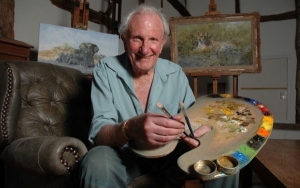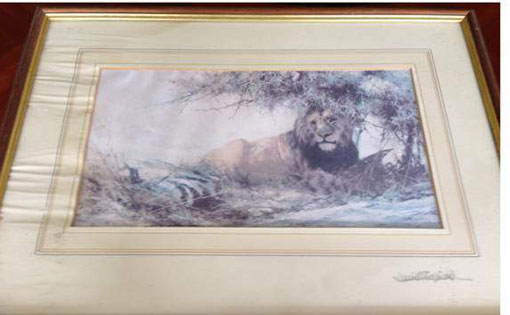MAN WHO REPAYS HIS DEBT TO ANIMALS AND PLANTS- Life Abroad – Part 85
Posted on June 26th, 2014
Dr. Tilak Fernando
David Shepherd is one of the worlds most respected and honoured wild life artists and conservationists. Since the 1960s, he has been exceptionally popular in limited edition print productions and posters of his own paintings. Born in Hendon, West London, he exhibited his latent talents in painting at the age of eight in a children’s painting competition titled – ‘Nursery World’ .
 |
 |
His interest in conservation was brought about during an expedition into the African Bush where he discovered a poisoned water hole with a considerable number of dead Zebras. Ever since, he has become an outspoken campaigner devoting much of his time for the protection of nature and animals.
Queen’s honours
David Shepherd was decorated with an OBE on December 31, 1979 for services to the conservation of wildlife; appointed Commander of the Order of the British Empire (CBE) in the 2008 in Queen’s Birthday Honours for services to charity and wildlife conservation. My good friend and artist, the late Don Hubert, introduced me to this world famous Wild Life painter in Guildford, Surrey in August 1993.
After his first disappointment in life in the 1930s when his application to become a game warden in Kenya was rejected by the Kenyan authorities, David Shepherd returned to England with a single determination to take up painting. British artist Robin Goodwin trained him for three years.
He received his first commission while in Kenya, from the Royal Air Force, to execute two paintings in 1960. With much enthusiasm when he started painting aircraft, his supervisors barked at him saying we do not want paintings of aircraft; do you do local subjects such as elephants”? David reminisced his first beginnings sentimentally. Since then, over the years, his popularity as a wild life painter grew and he became increasingly aware of the fragility of the animals ‘existence’. This was what primarily led towards the establishment of the David Shephard Conservation Foundation in 1985.
By displaying his commitment towards Wild Life, David Shepherd has been able to raise two million British Pounds for Wild Life conservation. His most popular painting titled ‘Tiger Fire’ alone managed to raise £127,500; ‘African Afternoon’ painting of Bongo managed to raise £80,000 for the Tropical Rain Forest Campaign the 1990s.
At the time I met him in 1993, he had become the busiest artist in the world where he had to accommodate a three year back log of commissioned work to his busy schedule. David Shepherd is a legend and a one man show. Whether he was in Africa, New York or in London there was always a queue of people to buy his paintings; invariably such sales encouraging him to continue with more and more paintings.
Philosophy
He believed that, man was on a suicidal course and the time was running out for countless species and the world belongs to the animals too and we all form part of this intricate and priceless web of life”. He also endorsed the fact that, ‘if we (human beings) continue to destroy the trees, wild life and their habitat, man will ultimately destroy himself’. In all seriousness he warned that, ‘the lesson had to be learnt quickly’, for, in our infinite wisdom, we also have an unparallel ability to repair the damage, but only very little time in which to do so!
In a rather emotional tone David Shepherd sounded disappointed when he said, we shall have a debt to pay for our stay in this planet” but appeared delighted to have been be born in this life and being able to repay the debt he owed to the animals and plants in fair measure – he thought such meritorious deeds have brought him such success in life.
David shepherd, being in a unique position to accomplish this through his paintings by raising very large sums of money for conservation of Wild Life and the habitat, established his own Foundation to co-ordinate his dedicated activities and exploit and maximise this potential. To execute this task to from tip to toe he received the unreserved enthusiasm from the Founder President of The Wild Life Fund, H.R.H. Prince Bernard of the Netherlands.
World wide experience
David had so much of experience to tell of his many visits to Africa, India, Sri Lanka and many other destinations in the world. His experiences and stories on people and animals that registered in his camera during such fascinating trips were later translated on to canvas, to pay his debt to animals.
The real turning point came to David Shepherd’s life when he received a letter from the British Forces Arabian Peninsula, Group Captain who said to his ADC (aide de camp); We must get this chap Shepherd out here to paint for us”. The 36” x 24” picture of Slave Island in Aden” which he painted on canvas transformed his whole future career and life. He remembered vividly when he painted Belihan Village in the Radfan, (prior to the World War II); how locals who had never seen an artist before thought that the palm trees he painted were real!
Nearly fifty years ago when he painted the ‘Wise old Elephant’, he had to persuade the publishers to print it, but they were reluctant to do so maintaining that ‘No one would want to buy an elephant’! Years later 250,000 people had bought that particular painting!
David Shephard seemed to find fund raising very simple, and naturally he liked to illustrate how exciting it was to raise money for charity. To my query as to what was by far the most celebrated picture he had painted, quick came the answer as Tiger Fire”.
David Shepherd’s idea was that Tigers were the most magnificent animals in his view point and he sounded highly worried about it being on the brink of extinction. According to this world renowned Wild Life enthusiast and Conservationist Tigers had been reduced from 40,000 in 1947 to 1,827 in India (at the time of the interview). Being extremely worried about the plight of this species he launched a program called Operation Tiger” in 1973 for the World Wild life Fund and flew to India to see a Tiger before he could paint one, but had to return being disappointed after having spent three weeks in the Indian jungles.
Face to face with a tiger
He had never seen a live tiger or painted one before in his life. His first experience was rather hair-raising and hilarious (now when one listens to it). He had been inside the Canterbury Zoo where he had come face to face with a tiger for the first time in life. Zharif” had been a huge tiger in a large metal enclosure and when David Shepherd entered the area, the iron gate clanged shut behind him waking Zharif up from a nap.
Zharif came bouncing towards me with full of expression, I simply stood there stiff, feeling rather foolish. All I could manage was to hear the keeper shouting at me saying, ‘Just stand still and let him get to know you’. Next minute Zharif rolled over the ground with his legs up in the air and allowed me to rub his white fluffy tummy. Then it suddenly got up, pointed his back at me, lifted his tail and squirted urine all over me! That was how the Tiger Fire made it appearance on the canvas to generate over quarter of a million pounds sterling’, he explicated. He has also donated a ‘Tiger painting’ to Mrs. Indira Gandhi which has managed to raise £50,000 for the Indian Conservation authorities.
David Shephard recollected how he visited Sri Lanka many moons ago and commented on Yala being the top two or three international parks that he had seen during many of his visits to a considerable number of countries. “Yala is a glorious place and I saw more leopards in one day there than I have seen in probably forty visits over the years to African National parks! It’s a pity that more people in the world do not know about the place because it must have huge potential for eco-tourism in Sri Lanka,” he commented.
‘Why didn’t the Indian elephant get the same publicity that its African cousin got’? I asked David Shephard finally. His answer was: “I do agree whole heartedly with you on your comments. We are doing our bit, I do assure you, I have been in touch with the conservation authorities in Sri Lanka with a view to raising funds for them, but it’s simply a question of time. Don’t worry, Sri Lanka is there, and I will be still around for some time”, he replied with a smile.
Finally I was curious to find out from David Shephard, the world famous Wild Life Painter, what would he have done if providence didn’t make him a distinguished Wild Life painter?
His answered briefly with a broad smile: “A Guildford Bus Driver”
